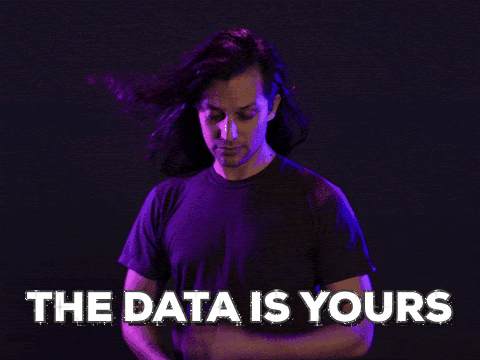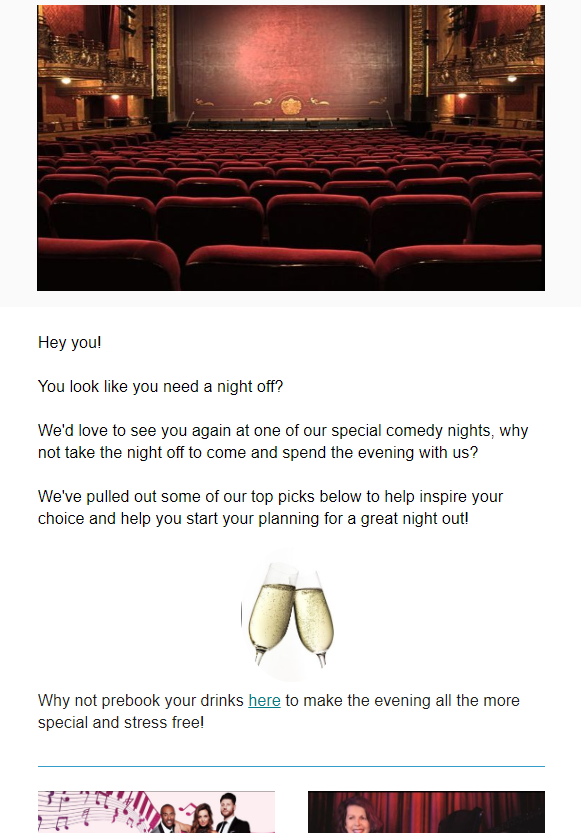Ticketsolve Customer Success: A Guide to Crossover Reporting and Segmentation, Webinar Summary

In their first intro webinar, Customer Success gurus Aoife and Sarah explained, what Power BI is, what data you can mine from it, and why understanding your data story is so important. In part two of The Customer Success Team’s Business Intelligence for the Arts Webinar series, they took us through customer segmentation, why it’s important, how to do it and how to encourage your audiences to book again and again with targeted, segmented messages.
In their Power BI webinar series, Sarah and Aoife will help you understand your data story. They will take you through Power BI step by step, so you can make sense of your data, and use it wisely. After each webinar, you can stop by our blog to get an overview of what Sarah and Aoife covered, and as always if you want more detail - get in touch!
So let’s get started with Part 2 in the Power BI webinar series.
Crossover Reporting and Segmentation

When we are tackling segmentation one of the easiest ways to get started is to look at your customer data based on genre. That is, which customers map to which genres and specifically if they have booked before and are no longer booking. With the information, you can tailor your content to that genre-specific segment. This targeting is key to draw those audiences back in and book again. Within Ticketsolve you can easily identify which customers should be booking for certain shows and target them with those last minute offers.
Of course, this means more bookings for you, but also it means that those audiences are getting content they love!
Now, this does not mean we advocate siloing your audiences into their genre bucket. On the contrary, when you start digging into your data, you will be guaranteed to uncover more about them than you previously knew - and thus breaking them out of their silo and finding your crossover.
As Indigo’s Katy Raines explains,
When you take a non-segmented approach what is likely happening?
-
“We’ve promised the promoter that their show will be included in emails to [x] many people”
-
“We send a weekly email to everyone on our mailing list about all the forthcoming events”
-
“We still need to sell [x] tickets, so we need to keep finding people to email until we’ve reached the target”
-
“It’s so cheap so send emails that we might as well send as many as we can”
But the consequences are . . .
-
The returns are always lower
-
You therefore have to increase the frequency with which you email people to achieve the same results
-
They get annoyed
-
They unsubscribe
-
You’ve then lost ANY ability to talk to them again
How Do You Target Your Audiences - Be Honest :)

Think about how you target your audiences at the moment. Do you send them your full programme? There is a certain logic in this of course. You don’t want your customers to miss out on shows and events they might potentially be interested in. But is really a (costly) scattershot approach - especially in today’s world where everything is very, very targeted and personalised.
By looking at your data and finding out what else your customers are interested in, you can open up new ways to connect with your audiences . . . and cut down on your marketing budget to boot.
How Well Do You Know Your Customers?

Even just on gut instinct - I bet you know your customers pretty well. You probably understand at a high-level who your audiences are. But - no judgements here - do you really know them? Maybe not.
Let’s take a look at Panto bookers as an example.
We don’t even need to look at data to get a basic understanding of who they are.
-
Family bookers
-
Only attend once a year
-
Typically buy 3 -4 tickets
-
Parents or Grandparents with younger children
So let’s go one step further and look at some secondary characteristics of this audience.
-
Disposable income
-
Interest in live entertainment
-
Free time
Here is where it gets interesting. Let’s now take a look at the data. In this example, we’re looking at some data about this audience from New Theatre Royal Lincoln:
Seasonal Pantomime bookers also attended some of the following shows:
-
80’s Mania
-
A Celebration of Michael Buble
-
An Evening of Burlesque

By drilling down into the data, we can now see that what appears to be on the surface just a panto audience crosses over to other genres. Now we can target them with other genres and shows.

Let’s look at another example from Lime Tree Theatre. They wanted to promote children’s shows that have an element of traditional music and expand their audience. Looking at their data, they targeted past bookers of trad music events. What the data revealed was that adults attending traditional Irish music shows might be more inclined to book childrens shows if it encompasses the adults’ own interests. If they had not looked closely at their data, they would have missed this important audience segment.
Why Segmenting and Targeting Works
Think about your life. The marketing emails you get, the ads you see, the social media posts that really resonate with you. The ones you take notice of, click on, engage with are those that hit a nerve or are directly aimed at your interests. In other words, they are specific to you - they are targeted.
Segmented, targeted marketing shows understanding, increases conversions and saves you time and money.
Understanding Your Customers
-
Segmenting and targeting show your customers you understand their interests and you are listening.
-
Maintains better relationships with customers
Increases Conversions
-
Mailchimp shows a 23% higher open rate for segmented emails versus generic emails
Saves You Time, Money and Thinking
-
Segmentation and targeting cuts down on marketing spend
-
It’s easier to create campaigns and messages when it is very targeted. You’ll know exactly what to say. With more insight into who you’re talking to, messages can be shorter and more targeted to exactly what this segment of your audience needs to hear
Learn as You Go
Keep in mind this is a changing and shifting landscape. It is okay to learn as you go. The more data you delve into the more you’ll learn. The more targeted messages you create for smaller segments the more you’ll learn. And in that way, you’ll just get better and better as you go.
Customer Success and Business Intelligence Webinar 3: Customer as Individuals
For our penultimate BI webinar, we will be looking into how individual your customers are, and how by knowing them better, you can increase the effectiveness of your marketing strategy.
-
Learn how to identify customers based on their loyalty and effective ways to segment them so you are treating your loyal customers and casual customers in ways which will work for both groups.
-
See examples of effective segmentation based on locality. Optimise your local customer base and reach out to those further afield using Ticketsolve’s effective postcode reporting tool.
Join us on Thursday 26th March at 10:30am
Categories
Recent posts
Archive
- December 2025 (2)
- November 2025 (1)
- October 2025 (3)
- September 2025 (1)
- August 2025 (3)
- July 2025 (3)
- June 2025 (3)
- May 2025 (4)
- April 2025 (5)
- March 2025 (5)
- February 2025 (4)
- January 2025 (4)
- December 2024 (3)
- November 2024 (5)
- October 2024 (4)
- September 2024 (7)
- August 2024 (5)
- July 2024 (3)
- June 2024 (3)
- May 2024 (3)
- April 2024 (3)
- March 2024 (4)
- February 2024 (5)
- January 2024 (3)
- December 2023 (3)
- November 2023 (4)
- October 2023 (4)
- September 2023 (5)
- August 2023 (3)
- July 2023 (4)
- June 2023 (4)
- May 2023 (5)
- April 2023 (4)
- March 2023 (4)
- February 2023 (5)
- January 2023 (4)
- December 2022 (4)
- November 2022 (3)
- October 2022 (4)
- September 2022 (5)
- August 2022 (2)
- July 2022 (4)
- June 2022 (5)
- May 2022 (4)
- April 2022 (5)
- March 2022 (3)
- February 2022 (4)
- January 2022 (4)
- December 2021 (2)
- November 2021 (3)
- October 2021 (5)
- September 2021 (4)
- August 2021 (4)
- July 2021 (3)
- June 2021 (4)
- May 2021 (2)
- April 2021 (4)
- March 2021 (5)
- February 2021 (4)
- January 2021 (5)
- December 2020 (4)
- November 2020 (4)
- October 2020 (5)
- September 2020 (5)
- August 2020 (4)
- July 2020 (7)
- June 2020 (5)
- May 2020 (5)
- April 2020 (5)
- March 2020 (8)
- February 2020 (4)
- January 2020 (5)
- December 2019 (3)
- November 2019 (5)
- October 2019 (4)
- September 2019 (4)
- August 2019 (5)
- July 2019 (4)
- June 2019 (4)
- May 2019 (5)
- April 2019 (4)
- March 2019 (4)
- February 2019 (3)
- January 2019 (5)
- December 2018 (4)
- November 2018 (8)
- October 2018 (2)
- September 2018 (3)
- August 2018 (5)
- July 2018 (4)
- June 2018 (4)
- May 2018 (1)
- April 2018 (1)
- March 2018 (3)
- February 2018 (2)
- December 2017 (2)
- November 2017 (3)
- October 2017 (4)
- September 2017 (2)
- August 2017 (1)
- July 2017 (5)
- June 2017 (3)
- May 2017 (2)
- April 2017 (3)
- March 2017 (2)
- February 2017 (3)
- January 2017 (3)
- December 2016 (4)
- November 2016 (1)
- September 2016 (1)
- July 2016 (3)
- June 2016 (1)
- May 2016 (2)
- April 2016 (2)
- February 2016 (1)
- January 2016 (3)
- December 2015 (2)
- September 2015 (1)
- August 2015 (2)
- July 2015 (1)
- June 2015 (2)
- May 2015 (2)
- April 2015 (5)
- March 2015 (2)
- February 2015 (2)
- January 2015 (4)
- December 2014 (3)
- November 2014 (3)
- October 2014 (2)
- September 2014 (3)
- August 2014 (3)
- July 2014 (3)
- June 2014 (7)
- May 2014 (6)
- April 2014 (3)
- March 2014 (2)
- February 2014 (1)
- January 2014 (3)
- December 2013 (1)
- August 2013 (1)
- June 2013 (1)
- April 2013 (1)
Sign up for regular updates



